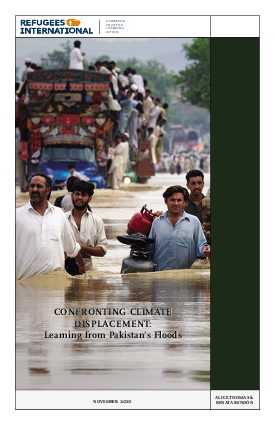
In July 2010, massive rain in Pakistan led to unprecedented flooding that submerged one-fifth of the country and affected more than 20 million people. While many experts believe the floods were the result of climate change, others say the science is uncertain. Regardless, most agree that natural disasters are occurring more frequently and that the international community is ill-equipped to respond. It is estimated that by 2050, as many as 200 million people will be displaced by natural disasters and climate change. The world’s poorest and most crisis-prone countries will be disproportionately affected.
This report explores what climate-induced displacement looks like and outlines steps to ensure that U.S. and international agencies address the threat that climate change poses to economic, political and human security. (See a full list of recommendations on page 20.) By evaluating and learning from the emergency response, the international community can implement more effective mechanisms and programs to prevent and respond to displacement from future natural disasters of this magnitude.
When the flooding began, the United Nations “cluster system” — whereby relief agencies coordinate efforts around a humanitarian service — was unable to respond effectively due to insufficient staff, resources and leadership. The UN should review the mechanisms available to prepare for and respond to large-scale disasters and focus on ways to improve cluster leadership. In regions where future disasters are likely, the UN Country Team should work closely with national governments and in-country climate experts to map at-risk areas and devise potential disaster scenarios.
Comprehensive early recovery programs that rebuild homes, community infrastructure and livelihoods must also help people who were vulnerable before the floods hit. The poor and land- less will be affected the most by the floods over the long term, and the UN and donors should work with the Pakistani government to ensure that reconstruction dollars do not reinforce pre-existing inequities by favoring landowners. In addition, programs must be put in place now to assist communities living in at-risk areas to voluntarily relocate to avoid having them move back to flood-prone areas because they have no other options.
The United States also has an important role to play given the international humanitarian community’s limitations in responding to rapid onset disasters. The U.S. government has invested over $15 billion in mostly security assistance to Pakistan since September 11, 2001, and recent legislation authorized another $7.5 billion over five years in economic assistance. But despite Pakistan’s high climate vulnerability, U.S. assistance only marginally aims to help avoid such calamities. Special Representative for Afghanistan and Pakistan Ambassador Richard Holbrooke should prepare a strategy report that discusses how U.S. assistance will address climate vulnerability in both Pakistan and Afghanistan.
If the United States wants to continue to lead the world in humanitarian assistance, it must be prepared to assist the millions of people displaced by climate-related disasters. First, the Secretary of State, in consultation with other relevant federal agencies and non-governmental organizations, should conduct an assessment and develop guidelines for a whole- of-government response to mitigate projected increases in long-term displacement as a result of climate hazards. Second, President Obama should request, and the Congress should pro- vide, increased funding for disaster preparedness and response and for displaced populations through the State Department’s refugee bureau and U.S. Agency for International Development’s (USAID) Office of Foreign Disaster Assistance. Third, it is critical that the State Department and USAID develop a clear government-wide policy and guidelines for preventing and responding to internally displaced persons.
The floods in Pakistan are an opportunity to draw lessons and address some of the underlying factors that rendered so many people vulnerable to begin with. The failure to do so could undermine the long-term stability of countries likely to experience increased floods, storms, droughts and other climate-related events. Given the high costs of responding to natural disasters, it is in the global community’s best interest to plan now for the massive displacement they cause and protect those most at risk.